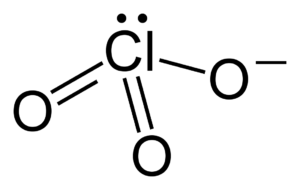Chlorate Formula
Chlorate
Chlorate Formula- It (chlorate anion) has the formula ClO–3. Moreover, in this case, the chlorine atom is in the +5 oxidation state. We can refer to chlorate is a chemical compound that contains anion; also chlorates are salts f chloric acid. Furthermore, when we use a Roman number with chlorates in parentheses for example chlorate (VII) then it refers to a particular oxyanion of chlorine.
They are powerful oxidizer that’s why they should be kept away from organics or easily oxidized materials. Also, chlorates combinations with virtually any combustible material (sawdust, sugar, organic solvents, charcoal, metals, etc.) will deflagrate. Once chlorates were widely used in pyrotechnics for this reason, still their use has fallen due to their instability. Now, most of the pyrotechnics applications that use chlorates are now use more stable perchlorates in its place.
Chlorates Formula and Structures
The chemical formula of chlorate is ClO3. Also, we cannot represent it satisfactorily by just one Lewis structure, as all the Cl–O bonds are of the same length (1.49 Å in potassium chlorate). Also, the chlorine atom is hypervalent. In its place, it is often thought of as a hybrid of multiple resonance structures.
In addition, chlorate anions have trigonal pyramidal structures which the Valance Shell Electron Pair Repulsion Theory (VSEPR theory). The molar mass of chlorates is 106.44 g/mol.

Preparation of Chlorates
On an industrial scale, we prepare chlorates by the synthesis for sodium chlorate starts from aqueous sodium chloride (brine) instead of chlorine gas.
Moreover, if the equipment for electrolysis allows for mixing of the chlorine and the sodium hydroxide, then the disappropriation reaction occurs. In addition, the heating of the reactants to 50-70 oC is accomplished by the electrical power used for electrolysis.
Occurrence of Chlorates
In a recent study, we discover the occurrence of natural chlorate deposits around the world, with relatively high concentrations that we find in arid and hyper-arid regions. Furthermore, we can measure them in rainfall samples with the amount of chlorate similar to perchlorate.
We also suspect that chlorate and perchlorate may share a common natural formation mechanism and it could be part of the chlorine biogeochemistry cycle. Furthermore, from the microbial position, the presence of natural chlorate can also explain why there are a variety of microorganisms that are capable of reducing chlorate to chloride.
Moreover, the evolution of chlorate reduction may be an ancient phenomenon as all perchlorate-reducing bacteria defined to utilize chlorate as a terminal electron acceptor. Currently, we do not know any chlorate-dominant minerals. However, in 2011 a study by Georgia Institute of Technology reveals the presence of magnesium chlorate on the planet Mars.
Compounds of Chlorates
The various examples of chlorates (salts) include:
- Sodium Chlorate- NaClO3
- Potassium Chlorate- KClO3
- Magnesium Chlorate- Mg(ClO3)2
Oxyanions of Chlorates
If Chlorate is keeping on by a Roman numeral then this indicates the oxyanion contains chlorine in the oxidation state. Moreover, using this convention, “chlorate” means any chlorine oxyanion. Most noteworthy, chlorate refers to only that chlorine is in the +5 oxidation state.
Toxicity of chlorates
Generally, the chlorates are relatively toxic although they from harmless chloride on reduction.
Solved Example for You
Question: Mention a method to prepare metal chlorates?
Solution: We can prepare metal chlorates by adding chlorine to a hot metal hydroxides lie KOH:
3Cl2+ 6KOH → 5KCl + KClO3+ 3H2O
Explanation: In this reaction, chlorine gas undergoes disproportionation, both reduction, and oxidation. Also, chlorine oxidation number is 0 forms chloride Cl–(oxidation number -1) and chlorate (V) ClO–3(Oxidation number +5). In addition, the cold aqueous metal hydroxides with chlorine produce the chloride and hypochlorite (Oxidation number +1) in its place.